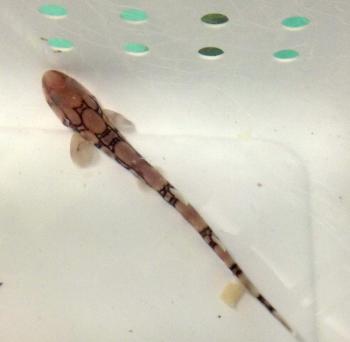Aquarium welcomes pups
Most depictions of the calendar flipping to a new year feature Father Time and Baby New Year, so it was fitting for the Maine State Aquarium to welcome 2013 with a baby of its own.
Three of them, actually.
The aquarium welcomed three chain catsharks (Scyliorhinus retifer), which are also called chain dogfish, to its ranks in early December 2012.
Aquarium Manager Aimee Hayden-Roderiques said the pups are most welcome in the new year.
“Over the last four years, we have been steadily accumulating (through other aquariums) a population of and attempting to breed these catsharks,” she said. “We have had some minor successes in the area over the last four years, but this year was an exceptionally productive mating year and these three are the results of that.
“While not all egg cases that are laid are fertilized and not all fertilized eggs make it to hatching, these three have already beaten the odds and we will continue to care for them, hoping that they grow to maturity and we can continue exhibiting this great species for many years to come.”
Chain catsharks can be found throughout the lower Gulf of Maine and below. Large populations of chain catsharks can be found along Georges Banks, the continental shelf and the Mid-Atlantic. Their remote habitats make it difficult to study them in the wild, Hayden-Roderiques said.
“They live in deeper waters (typically 1,800 feet or more) and oddly enough scientists do not know much about them as compared to other species,” she said, adding that their remoteness is not the only unusual fact about catsharks. “A neat fact, however, is that they fluoresce under blue light, the reason for which is still unknown.”
Their oddities combined with a generally laid-back attitude and the fact that they are readily bred in captivity have made the catshark an aquarium favorite, Hayden-Roderiques said.
“Many home aquarium owners (more experienced ones) also have these because of their hearty nature, small size, and beauty,” she said. “They seem to do well in touch-based aquariums, as compared to other species, and people seem to really enjoy the friendly, approachable nature of the species.”
Although relatively small, the chain catshark's bite, like its larger brethren, is mighty, Hayden-Roderiques said.
“They eat a variety of foods, which includes shrimp, squid, clams, marine worms, small crabs and lobsters and small fish,” she said. “While they may be a smaller shark species (but are not the smallest, by far) they still have teeth made for eating hard-shelled and bottom living organisms and can still take a mean bite when threatened or mishandled.
“As with any shark, we treat them with respect and try to avoid encounters with those many rows of tiny teeth.”
The gestation period for a catshark takes approximately 250 days, so the aquarium estimates that the pods from which they were hatched were released by the primary breeding female in March or April, 2012. Because the pods were in warm water during the spring and summer months the sharks hatched a little earlier than expected.
“We keep them in a temperature controlled tank in the winter months until the aquarium reopens each year for Memorial Day weekend when they are then placed on exhibit in our Shark & Skate Touch Tank,” Hayden-Roderiques said.
Soon the young catsharks could be joined by more siblings.
“We still have catshark eggs waiting for their turn to hatch and each season at the aquarium these developing sharks are on display, each case lit up from behind, so that guests can actually witness the amazing growth process inside the eggs themselves,” Hayden-Roderiques said.
Ben Bulkeley can be reached at 207-633-4620 or bbulkeley@boothbayregister.com. Follow him on Twitter: @BBRegisterBen.



































.png)
.png)

